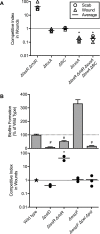Bacterial fitness in chronic wounds appears to be mediated by the capacity for high-density growth, not virulence or biofilm functions
- PMID: 30893371
- PMCID: PMC6448920
- DOI: 10.1371/journal.ppat.1007511
Bacterial fitness in chronic wounds appears to be mediated by the capacity for high-density growth, not virulence or biofilm functions
Abstract
While much is known about acute infection pathogenesis, the understanding of chronic infections has lagged. Here we sought to identify the genes and functions that mediate fitness of the pathogen Pseudomonas aeruginosa in chronic wound infections, and to better understand the selective environment in wounds. We found that clinical isolates from chronic human wounds were frequently defective in virulence functions and biofilm formation, and that many virulence and biofilm formation genes were not required for bacterial fitness in experimental mouse wounds. In contrast, genes involved in anaerobic growth, some metabolic and energy pathways, and membrane integrity were critical. Consistent with these findings, the fitness characteristics of some wound impaired-mutants could be represented by anaerobic, oxidative, and membrane-stress conditions ex vivo, and more comprehensively by high-density bacterial growth conditions, in the absence of a host. These data shed light on the bacterial functions needed in chronic wound infections, the nature of stresses applied to bacteria at chronic infection sites, and suggest therapeutic targets that might compromise wound infection pathogenesis.
Conflict of interest statement
The authors have declared that no competing interests exist.
Figures






Similar articles
-
Pseudomonas aeruginosa uses T3SS to inhibit diabetic wound healing.Wound Repair Regen. 2015 Jul-Aug;23(4):557-64. doi: 10.1111/wrr.12310. Epub 2015 Jul 27. Wound Repair Regen. 2015. PMID: 25912785 Free PMC article.
-
Chronic Pseudomonas aeruginosa biofilm infection impairs murine S100A8/A9 and neutrophil effector cytokines-implications for delayed wound closure?Pathog Dis. 2017 Sep 29;75(7). doi: 10.1093/femspd/ftx068. Pathog Dis. 2017. PMID: 28645160
-
Pseudomonas aeruginosa Interstrain Dynamics and Selection of Hyperbiofilm Mutants during a Chronic Infection.mBio. 2019 Aug 13;10(4):e01698-19. doi: 10.1128/mBio.01698-19. mBio. 2019. PMID: 31409682 Free PMC article.
-
A review of the scientific evidence for biofilms in wounds.Wound Repair Regen. 2012 Sep-Oct;20(5):647-57. doi: 10.1111/j.1524-475X.2012.00836.x. Wound Repair Regen. 2012. PMID: 22985037 Review.
-
Pseudomonas aeruginosa Biofilm, a Programmed Bacterial Life for Fitness.J Microbiol Biotechnol. 2017 Jun 28;27(6):1053-1064. doi: 10.4014/jmb.1611.11056. J Microbiol Biotechnol. 2017. PMID: 28301918 Review.
Cited by
-
Small-Molecule Antibiotic Drug Development: Need and Challenges.ACS Infect Dis. 2023 Nov 10;9(11):2062-2071. doi: 10.1021/acsinfecdis.3c00189. Epub 2023 Oct 11. ACS Infect Dis. 2023. PMID: 37819866 Free PMC article. Review.
-
The Impact of the Skin Microbiome and Oxidative Stress on the Initiation and Development of Cutaneous Chronic Wounds.Antioxidants (Basel). 2025 Jun 4;14(6):682. doi: 10.3390/antiox14060682. Antioxidants (Basel). 2025. PMID: 40563316 Free PMC article. Review.
-
ZnO Nanoparticles-Modified Dressings to Inhibit Wound Pathogens.Materials (Basel). 2021 Jun 4;14(11):3084. doi: 10.3390/ma14113084. Materials (Basel). 2021. PMID: 34200053 Free PMC article.
-
Enzybiotics LYSSTAPH-S and LYSDERM-S as Potential Therapeutic Agents for Chronic MRSA Wound Infections.Antibiotics (Basel). 2020 Aug 15;9(8):519. doi: 10.3390/antibiotics9080519. Antibiotics (Basel). 2020. PMID: 32824115 Free PMC article.
-
Antibacterial, Antibiofilm, and Wound Healing Activities of Rutin and Quercetin and Their Interaction with Gentamicin on Excision Wounds in Diabetic Mice.Biology (Basel). 2024 Aug 29;13(9):676. doi: 10.3390/biology13090676. Biology (Basel). 2024. PMID: 39336103 Free PMC article.
References
-
- Lyczak JB, Cannon CL, Pier GB. Establishment of Pseudomonas aeruginosa infection: lessons from a versatile opportunist. Microbes Infect. 2000;2(9):1051–60. Epub 2000/09/01. S1286-4579(00)01259-4 [pii]. . - PubMed
Publication types
MeSH terms
Grants and funding
LinkOut - more resources
Full Text Sources
Other Literature Sources

